Theme Parks & Themed Entertainment
Marvelous Mechanized Magic Kingdom event dispelled many myths about Audio Animatronics
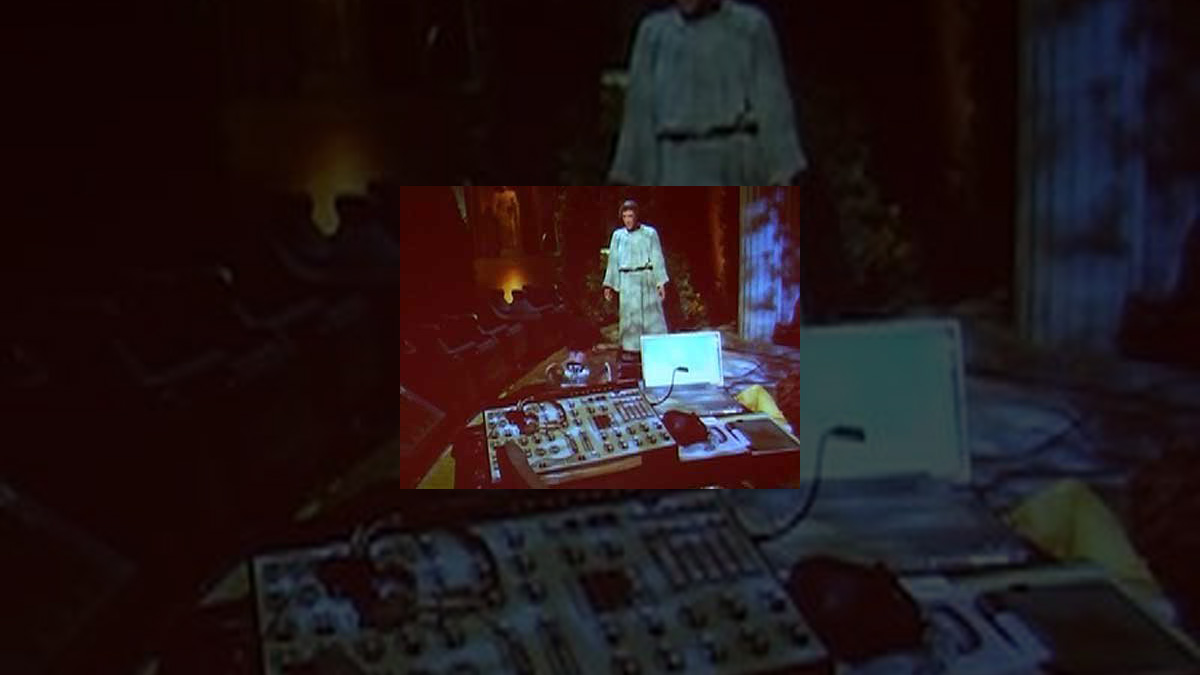
There are many myths associated with Audio Animatronics.
With the biggest one being that these mechanized marvels can do just about
anything that the Imagineers can dream up.
Not so says Imagineer Darrin Hughes. Who’s spent the past 20
years programming AA figures for Walt Disney Parks & Resorts. Truth be
told, even the most state-of-the-art Audio Animatronic can only replicate 2% of
human expression.
“No matter how much effort we put into them, all of the
talent that’s involved, AA figures can only do a few things very well. My guess
of about 2% is probably pretty generous,” Hughes stated at last year’s
Marvelous Mechanized Magic Kingdom event. “So the trick is to design Audio
Animatronics figures so that they then do these few things very well and that’s
all we show. “
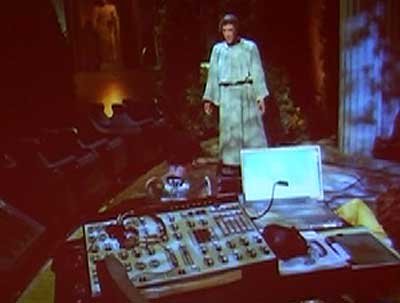
Image courtesy of Ape Pen Publishing. All rights
reserved
In some cases, it’s actually the lights, sets or costumes that make Disney’s AA
figures seem far more lifelike than they actually are. Take – for example – the
picture above. Which shows Darrin and his team reprogramming the Greek Teacher
in Epcot‘s Spaceship Earth ride.
“Unfortunately, you’re not seeing his full costume here. The
Greek Teacher had a beautiful red costume, which really made a huge difference
because — when this AA figure moved his arms — the sleeves would then move a little bit in
the breeze,” Hughes continued. “And by doing that, the movement of the costume
then provides this Audio Animatronic with a little natural motion. And that then
absorbs a little bit of the non-natural motion that I – as the programmer —
have a hard time getting past due to the mechanical nature of the Greek Teacher
AA figure.”
It was this sort of stuff that made Darrin’s Marvelous Mechanized Magic Kingdom
presentation so fascinating. The glamor of being an Imagineer who went to
exotic places like Hong Kong and then programmed AA figures in the field …
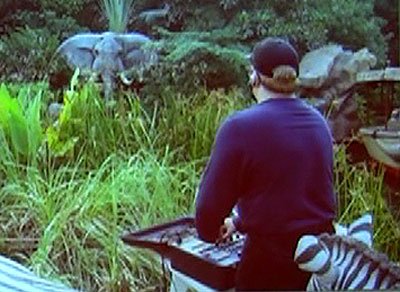
Image courtesy of Ape Pen
Publishing. All rights reserved
… quickly gave way to the harsh reality of what it was
actually like to program all of the mechanical animals that you see while floating
along on Hong Kong Disneyland‘s Jungle River Cruise.
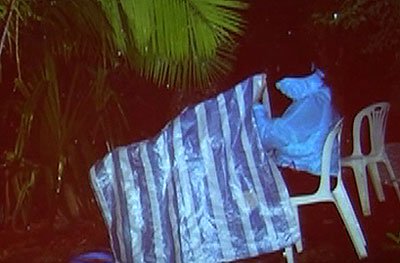
Image courtesy of Ape Pen Publishing. All rights
reserved
“This photo was taken just as the monsoon was arriving. The rain’s coming at
about a 45 degree angle here. But as you can see, I’m still on the job. Working
under that blue & white plastic tarp, trying to keep the rain from
electrocuting me as it shorts out my control system,” Hughes recalled. “What
that photo also fails to convey is the giant cockroaches that were flying
straight at me. As they tried to get out of the rain by seeking shelter under
my tarp.”
“And why was Darrin working in the pouring-down rain?,” you
ask. Because – as Hughes explained as part of his Marvelous Mechanized Magic
Kingdon presentation – he and his crew of AA figure programmers never ever have
enough time to do all of the work that they’re supposed to.
“One of the painful realities of working on a multi-million dollar project like
a theme park ride is opening day. That thing never, ever moves. It never moves
because there’s a project manager standing next to that date with a shotgun,”
Darrin smirked. “There is a project plan, a schedule that stretches from here
to San Diego. But the actual animation of the AA figures is the very last thing
on that schedule. I try to make the scheduled animation time as big as it can
possibly be. But it’s never enough. So I try and manage things as best I can.”
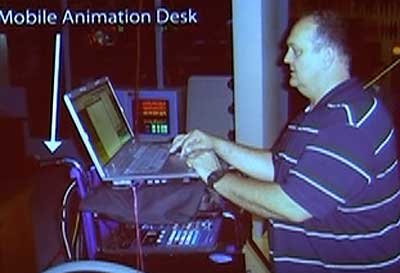
Eric Swapp working on programming the AA figures in Spaceship Earth’s
new computer room sequence. Image courtesy of Ape Pen
Publishing.
All rights reserved
Which means that Hughes and his teams have to be pretty ingenious sometimes when
it comes to the way they get their programming equipment in and out of the
various show buildings that they work. Take – for example – the photo above.
“This was taken while Eric Swapp and I were working inside
of Spaceship Earth. Now you may notice that the mobile programming desk that
Eric is using looks remarkably like a wheelchair. Well, that’s because it is a
wheelchair,” Darrin stated. “You see, Spaceship Earth has a long and winding
track. And given the tight working conditions we were working under back then,
we had to come up with a way to move our programming equipment quickly from
show scene to show scene. And a wheelchair seemed like the smartest way to go.”
And it’s not just that the working conditions that Hughes and his crew deal
with regularly are tight. They can also be extremely dangerous. As part of his
presentation, Darrin revealed that one member of the “ExtraTERRORestrial Alien
Encounter” show installation team was badly
injured because of a mistake that was made in the field while they were
programming that Tomorrowland attraction.
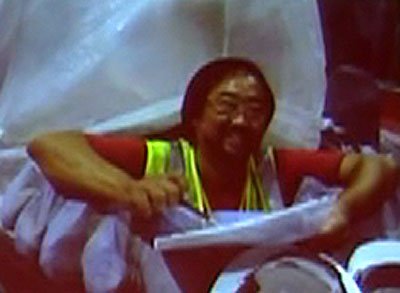
Steven Kosakura working in a pretty tight spot while installing an
animatronic in the field. Image courtesy of Ape Pen Publishing.
All rights
reserved
“You see this picture of my friend, Steven Kosakura? This was taken while we
were installing an enormous animatronic figure at a non-Disney park,” Hughes
explained. “Now if I had accidentally pressed the wrong button while I was
programming this figure, a big steel thing will come straight up through the
hole where Steve is sitting in this picture. Likewise, if I pressed a different
wrong button, the thing that this animatronic is holding would have come crashing
down and crushed Steve’s head. The field can be extremely dangerous. Which is
why we always have to be super-aware of what’s going on around us, the show
environment, etc.”
But even with all the hassles & the
risks involved, Darrin is still obviously a fan of this commercial art form.
More to the point, he is quick to praise this form of commercial entertainment.
Especially those Disney Legends like Wathel Rogers who actually pioneered the
development of AA figures.
“But it’s not just the pioneers who developed Audio Animatronics. I also need
to pay tribute to the other people I work with regularly. The art directors,
the effects people, the figure finishers, the guys who handle the lighting
inside of the rides, the writers who create the scripts for these attractions,”
Hughes continued. “If they haven’t done their job to the best of their
abilities, given me everything that I need in order to bring that figure to
life … Well, the Guests aren’t going to see this figure come to life either.”
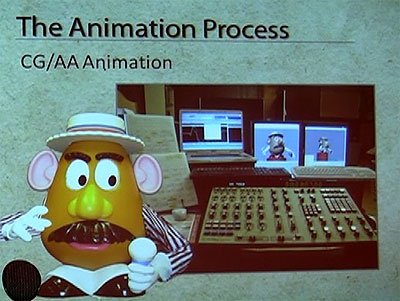
Image courtesy of Ape Pen
Publishing. All rights reserved
Besides, thanks to advances in technology, Darrin no longer
always has to go to the field to do all of the programming for the Audio
Animatronics that he’s working. Take – for example – Mr. Potato Head from “Toy
Story Mania!“
“Because we were able to do pre-programming of Mr. Potato
Head in the computer, I didn’t actually have to go down to California Adventure
except to put the data onto the real figure. I was able to work in my office,
Which was really cool. I’d like to be able to do more of that,” Darrin said.
Unfortunately, not all of the Audio Animatronics that Hughes works on are
NextGen like Mr. Potato Head. Which means – in order to get them to work
properly, to get the sort of performance out of this figure that will really
enhance the ride, get some sort of emotional response out of the audience that’s
viewing this attraction … Well, that means hours & hours of work. Often under
in some pretty difficult and frustrating working conditions.
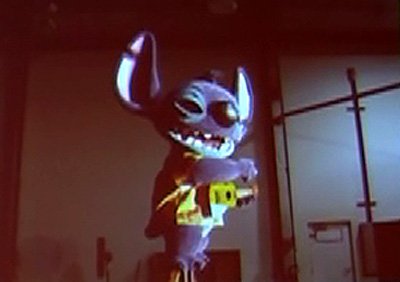
Pre-programming the Stitch figure for the revamped version of Tokyo
Disneyland’s “Enchanted Tiki Room.” Image courtesy of Ape Pen
Publishing. All rights reserved
“You have to understand that – when we’re doing the initial
installation — is that everybody wants to be on that figure. The costumers
want to be making changes, as they try & figure out why their costume is twisting
funny whenever this figure moves. There are mechanical problems that invariably
need to be fixed. Plus the ride guys keep kicking me out for whatever reason,”
Hughes explained. “So it’s really hard under those sorts of conditions to stay
on the figure and just keep working.”
Which is why – whenever possible – Darrin likes to get some
time with the AA figure that he’s supposed to be working on before it’s
actually sent to the field and then hole up in some airplane hangar or warehouse
on the WDI campus and do as much
animation in advance as he possibly can.
“Sometimes we’ll do a full mock-up. In the case of Sindbad,
we built all of the sets. It kind of depends on the show. How many risks we’ve
identified, what we need to prove,” Hughes said. “That’s why you always want to try and do as
much programming as you can in advance. So that you don’t find yourself in the
field having a big problem. It’s mostly about managing risks in my mind.”
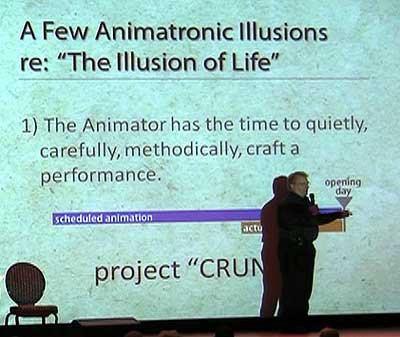
Darrin Hughes speaking at Last year’s Marvelous Mechanized Magic
Kingdom event. Image courtesy of Ape Pen
Publishing.
All rights reserved
Given all of the complex issues that Darrin usually deals
with whenever he’s programming a new Audio Animatronic (FYI: That’s pretty much
how Hughes describes his job. He doesn’t see himself as a figure programmer.
But – rather – as a guy who manages complexity. Someone who – before he gets
the chance to do his job well – first has to ” … get as much done early on to help mediate
risks and talk to all of the other disciplines.) … Well, the fanboy view of the
Disney theme parks then becomes kind of laughable. While some may insist that all
the Imagineers need to do to change the “Under New Management” show in the
Sunshine Pavilion at WDW’s Magic Kingdom is upload the old “Enchanted Tiki Room”
programming and then hit a few switches … After hearing Darrin Hughes talk, you
realize that this simply isn’t the case.
In fact, I wish that every Disney fan who has ever
complained about the Yeti in “Expedition Everest” at Disney’s Animal Kingdom
could listen to Darrin Hughes’ talk about the herculean effort that it takes to
install, program and then maintain an Audio Animatronic figure.
Come to think of it, they actually can. On May 1st, Ape Pen Publishing will be releasing a new 2-DVD set. Which will not only feature the
presentations that Darrin Hughes gave at this Marvelous Mechanized Magic
Kingdom event, but also captures the insights that Disney Legends like X
Atencio, Alice Davis, Kathryn Beaumont, Bob
Gurr and Floyd Norman shared about the early, early days of AA figures. Not to
mention what Hughes’ contemporaries – Imagineers like Larry Nikolai, Ethan Reed
and Josh Shipley – have to say about this form of commercial entertainment.
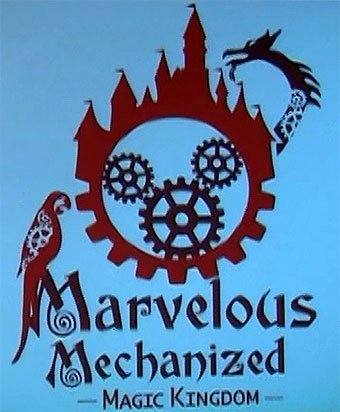
Image courtesy of Ape Pen
Publishing. All rights reserved
So if you’d like to learn more about the realities of
working with Audio Animatronics, rather than the fanboy fantasies that you’ll
find on the Web … Might I suggest that you pick up a copy of Ape Pen Publishing’s
Marvelous Mechanized Magic Kingdom DVD. Which goes on sale May 1st.
Your thoughts?
Theme Parks & Themed Entertainment
Disney and Macy’s 90-Year Thanksgiving Day Parade Partnership: From Mickey’s First Balloon to Minnie’s Big Debut

Now, folks, if you’re like me, Thanksgiving just wouldn’t be the same without a coffee, a cozy seat, and Macy’s Thanksgiving Day Parade on the TV. And if you’re really like me, you’re watching for one thing: Disney balloons floating down 34th Street. Ever wondered how Mickey, Donald, and soon Minnie Mouse found their way into this beloved New York tradition? Well, grab your popcorn because we’re diving into nearly 90 years of Disney’s partnership with Macy’s.
The Very First Parade and the Early Days of Balloons
The Macy’s Thanksgiving Day Parade goes way back to 1924, but if you can believe it, balloons weren’t part of the festivities until 1927. That first lineup included Felix the Cat, a dragon, and a toy soldier, all towering above the crowds. Back then, Macy’s had a pretty wild idea to end the parade: they would let the balloons drift off into the sky, free as birds. But this wasn’t just Macy’s feeling generous. Each balloon had a message attached, offering a $100 reward (about $1,800 in today’s dollars) for anyone who returned it to the flagship store on 34th Street.
And here’s where it gets interesting. This tradition carried on for a few years, right up until 1932, when Felix the Cat almost took down a plane flying over New York City! Imagine that—you’re flying into LaGuardia, and suddenly, there’s a 60-foot balloon drifting toward your wing. Needless to say, that was the end of Macy’s “fly away” stunt, and from then on, the balloons have stayed firmly grounded after the parade ends.

1934: Mickey Mouse Floats In, and Disney Joins the Parade
It was 1934 when Mickey Mouse finally made his grand debut in the Macy’s parade. Rumor has it Walt Disney himself collaborated with Macy’s on the design, and by today’s standards, that first Mickey balloon was a bit of a rough cut. This early Mickey had a hotdog-shaped body, and those oversized ears gave him a slightly lopsided look. But no one seemed to mind. Mickey was there, larger than life, floating down the streets of New York, and the crowd loved him.
Mickey wasn’t alone that year. He was joined by Pluto, Horace Horsecollar, and even the Big Bad Wolf and Practical Pig from The Three Little Pigs, making it a full Disney lineup for the first time. Back then, Disney wasn’t yet the entertainment powerhouse we know today, so for Walt, getting these characters in the parade meant making a deal. Macy’s required its star logo to be featured on each Disney balloon—a small concession that set the stage for Disney’s long-standing presence in the parade.
Duck Joins and Towers Over Mickey
A year later, in 1935, Macy’s introduced Donald Duck to the lineup, and here’s where things got interesting. Mickey may have been the first Disney character to float through the parade, but Donald made a huge splash—literally. His balloon was an enormous 60 feet tall and 65 feet long, towering over Mickey’s 40-foot frame. Donald quickly became a fan favorite, appearing in the lineup for several years before being retired.
Fast-forward a few decades, and Donald was back for a special appearance in 1984 to celebrate his 50th birthday. Macy’s dug the balloon out of storage, re-inflated it, and sent Donald down 34th Street once again, bringing a bit of nostalgia to the holiday crowd.
A Somber Parade in 2001
Now, one of my most memorable trips to the parade was in 2001, just weeks after the 9/11 attacks. Nancy and I, along with our friends, headed down to New York, and the mood was something I’ll never forget. We watched the start of the parade from Central Park West, but before that, we went to the Museum of Natural History the night before to see the balloons being inflated. They were covered in massive cargo nets, with sandbags holding them down. It’s surreal to see these enormous balloons anchored down before they’re set free.
That year, security was intense, with police lining the streets, and then-Mayor Rudy Giuliani rode on the Big Apple float to roaring applause. People cheered his name, waving and shouting as he passed. It felt like the entire city had turned out to show their resilience. Even amidst all the heightened security and tension, seeing those balloons—brought a bit of joy back to the city.

Balloon Prep: From New Jersey’s MetLife Stadium to California’s D23 Expo
Each year before the parade, Macy’s holds a rehearsal event known as Balloon Fest at MetLife Stadium in New Jersey. This is where handlers get their first crack at guiding the balloons, practicing with their parade masters, and learning the ropes—literally. It’s an entire production unto itself, with dozens of people rehearsing to make sure these enormous inflatables glide smoothly down the streets of New York on parade day.
In 2015, Macy’s took the balloon show on the road, bringing their Buzz Lightyear balloon out to California for the D23 Expo. I was lucky enough to be there, and watching Buzz get inflated piece by piece in the Anaheim Convention Center parking lot was something to behold. Each section was filled with helium in stages, and when they got around to Buzz’s lower half, well, there were more than a few gas-related jokes from the crowd.
These balloons seem to have a personality all their own, and seeing one like Buzz come to life up close—even outside of New York—had all the excitement and anticipation of the real deal.

Mickey’s Comeback as a Bandleader and Sailor Mickey
After a long hiatus, Mickey Mouse made his return to the Macy’s parade in 2000, this time sporting a new bandleader outfit. Nine years later, in 2009, Sailor Mickey joined the lineup, promoting Disney Cruise Line with a nautical twist. Over the past two decades, Disney has continued to enchant parade-goers with characters like Buzz Lightyear in 2008 and Olaf from Frozen in 2017. These balloons keep Disney’s iconic characters front and center, drawing in both longtime fans and new viewers.
But ever wonder what happens to the balloons after they reach the end of 34th Street? They don’t just disappear. Each balloon is carefully deflated, rolled up like a massive piece of laundry, and packed into storage bins. From there, they’re carted back through the Lincoln Tunnel to Macy’s Parade Studio in New Jersey, where they await their next flight.

Macy’s Disney Celebration at Hollywood Studios
In 1992, Macy’s took the spirit of the parade down to Disney-MGM Studios in Orlando. After that year’s parade, several balloons—including Santa Goofy, Kermit the Frog, and Betty Boop—were transported to Hollywood Studios, re-inflated, and anchored along New York Street as part of a holiday display. Visitors could walk through this “Macy’s New York Christmas” setup and see the balloons up close, right in the middle of the park. While this display only ran for one season, it paved the way for the Osborne Family Spectacle of Dancing Lights, which became a holiday staple at the park for years to come.

Minnie Mouse’s Long-Awaited Debut in 2024
This year, Minnie Mouse will finally join the parade, making her long-overdue debut. Macy’s is rolling out the red carpet for Minnie’s arrival with special pop-up shops across the country, where fans can find exclusive Minnie ears, blown-glass ornaments, T-shirts, and more to celebrate her first appearance in the Thanksgiving Day Parade.

For those lucky enough to catch the parade this year, you’ll see Minnie take her first float down 34th Street, decked out in her iconic red bow and polka-dot dress. Macy’s and Disney are also unveiling a new Disney Cruise Line float honoring all eight ships, including the latest, the Disney Treasure.
As always, I’ll be watching from my favorite chair, coffee in hand, as Minnie makes her grand entrance. The 98th annual Macy’s Thanksgiving Day Parade airs live on NBC, and it’s a tradition you won’t want to miss—whether you’re on 34th Street or tuning in from home.
Theme Parks & Themed Entertainment
Disney’s Forgotten Halloween Event: The Original Little Monsters on Main Street

When most Disney fans think of Halloween in the parks, they immediately picture Mickey’s Not-So-Scary Halloween Party at Walt Disney World or the Oogie Boogie Bash at Disneyland Resort. But before those events took over as the must-attend spooky celebrations, there was a little-known event at Disneyland called Little Monsters on Main Street. And its origins? Well, they go all the way back to the 1980s, during a time when America was gripped by fear—the Satanic Panic.

You see, back in the mid-1980s, parents were terrified that Halloween had become dangerous. Urban legends about drug-laced candy or razor blades hidden in apples were widespread, and many parents felt they couldn’t let their kids out of sight for even a moment. Halloween, which was once a carefree evening of trick-or-treating in the neighborhood, had suddenly become a night filled with anxiety.
This is where Disneyland’s Little Monsters on Main Street came in.

The Origins of Little Monsters on Main Street
Back in 1989, the Disneyland Community Action Team—later known as the VoluntEARS—decided to create a safe, nostalgic Halloween experience for Cast Members and their families. Many schools in the Anaheim area were struggling to provide basic school supplies to students, and the VoluntEARS saw an opportunity to combine a safe Halloween with a charitable cause. Thus, Little Monsters on Main Street was born.
This event was not open to the general public. Only Disneyland Cast Members could purchase tickets, which were initially priced at just $5 each. Cast Members could bring their kids—but only as many as were listed as dependents with HR. And even then, the park put a cap on attendance: the first event was limited to just 1,000 children.

A Unique Halloween Experience
Little Monsters on Main Street wasn’t just another Halloween party. It was designed to give kids a safe, fun environment to enjoy trick-or-treating, much like the good old days. On Halloween night in 1989, kids in costume wandered through Disneyland with their pillowcases, visiting 20 different trick-or-treat stations. They also had the chance to ride a few of their favorite Fantasyland attractions, all after the park had closed to the general public.
The event was run entirely by the VoluntEARS—about 200 of them—who built and set up all the trick-or-treat stations themselves. They arrived at Disneyland before the park closed and, as soon as the last guest exited, they began setting up stations across Main Street, Adventureland, Frontierland, Fantasyland, and Tomorrowland. The event ran from 7:30 to 9:30 p.m., and by the time the last pillowcase-wielding kid left, the VoluntEARS cleaned everything up, making sure the park was ready for the next day’s operations.
It wasn’t just candy and rides, though. The event featured unique entertainment, like a Masquerade Parade down Main Street, U.S.A., where kids could show off their costumes. And get this—Disneyland even rigged up a Cast Member dressed as a witch to fly from the top of the Matterhorn to Frontierland on the same wire that Tinker Bell uses during the fireworks. Talk about a magical Halloween experience!
The Haunted Mansion “Tip-Toe” Tour
Perhaps one of the most memorable parts of Little Monsters on Main Street was the special “tip-toe tour” of the Haunted Mansion. Now, Disneyland’s Haunted Mansion can be a pretty scary attraction for younger kids, so during this event, Disney left the doors to the Stretching Room and Portrait Gallery wide open. This allowed kids to walk through and peek at the Haunted Mansion’s spooky interiors without actually having to board the Doom Buggies. For those brave enough to ride, they could, of course, take the full trip through the Haunted Mansion—or they could take the “chicken exit” and leave, no harm done.

Growing Success and a Bigger Event
Thanks to the event’s early success, Little Monsters on Main Street grew in size. By 1991, the attendance cap had been raised to 2,000 kids, and Disneyland added more activities like magic shows and hayrides. They also extended the event’s hours, allowing kids to enjoy the festivities until 10:30 p.m.
In 2002, the event moved over to Disney California Adventure, where it could accommodate even more kids—up to 5,000 in its later years. The name was also shortened to just Little Monsters, since it was no longer held on Main Street. This safe, family-friendly Halloween event continued for several more years, with the last mention of Little Monsters appearing in the Disneyland employee newsletter in 2008. Though some Cast Members recall the event continuing until 2012, it eventually made way for Disney’s more public-facing Halloween events.

From Little Monsters to Mickey’s Not-So-Scary and Oogie Boogie Bash
Starting in the early 2000s, Disney began realizing the potential of Halloween-themed after-hours events for the general public. These early versions of Mickey’s Halloween Party and Mickey’s Halloween Treat eventually evolved into today’s Mickey’s Not-So-Scary Halloween Party and Oogie Boogie Bash. Unfortunately, this also marked the end of the intimate, Cast Member-exclusive Little Monsters event, but it paved the way for the large-scale Halloween celebrations we know and love today.
While it’s bittersweet to see Little Monsters on Main Street fade into Disney history, its legacy lives on through these modern Halloween parties. And even though Cast Members now receive discounted tickets to Mickey’s Not-So-Scary and Oogie Boogie Bash, the special charm of an event created specifically for Disney’s employees and their families remains something worth remembering.
The Merch: A Piece of Little Monsters History
For Disney collectors, the exclusive merchandise created for Little Monsters on Main Street is still out there. You can find pins, name tags, and themed pillowcases on sites like eBay. One of the coolest collectibles is a 1997 cloisonné pin set featuring Huey, Dewey, and Louie dressed as characters from Hercules. Other sets paid tribute to the Main Street Electrical Parade and Pocahontas, while the pillowcases were uniquely designed for each year of the event.

While Little Monsters on Main Street may be gone, it’s a fascinating piece of Disneyland history that played a huge role in shaping the Halloween celebrations we enjoy at Disney parks today.
Want to hear more behind-the-scenes stories like this? Be sure to check out I Want That Too, where Lauren and I dive deep into the history behind Disney’s most beloved attractions, events, and of course, merchandise!
Theme Parks & Themed Entertainment
The Story of Mickey’s Not-So-Scary Halloween Party: From One Night to a Halloween Family Tradition

The spooky season is already in full swing at Disney parks on both coasts. On August 9th, the first of 38 Mickey’s Not-So-Scary Halloween Party (MNSSHP) nights for 2024 kicked off at Florida’s Magic Kingdom. Meanwhile, over at Disney California Adventure, the Oogie Boogie Bash began on August 23rd and is completely sold out across its 27 dates this year.
Looking back, it’s incredible to think about how these Halloween-themed events have grown. But for Disney, the idea of charging guests for Halloween fun wasn’t always a given. In fact, when the very first Mickey’s Not-So-Scary Halloween Party debuted on October 31, 1995, it was a modest one-night-only affair. Compare that to the near month-long festivities we see today, and it’s clear that Disney’s approach to Halloween has evolved considerably.
A Not-So-Scary Beginning
I was fortunate enough to attend that very first MNSSHP back in 1995, along with my then 18-month-old daughter Alice and her mom, Michelle. Tickets were a mere $16.95 (I know, can you imagine?), and we pushed Alice around in her sturdy Emmaljunga stroller—Swedish-built and about the size of a small car. Cast Members, charmed by her cuteness, absolutely loaded us up with candy. By the end of the night, we had about 30 pounds of fun-sized candy bars, making that push up to the monorail a bit more challenging.

This Halloween event was Disney’s response to the growing popularity of Universal Studios Florida’s own Halloween hard ticket event, which started in 1991 as “Fright Nights” before being rebranded as “Halloween Horror Nights” the following year. Universal’s gamble on a horror-themed experience helped salvage what had been a shaky opening for their park, and by 1993, Halloween Horror Nights was a seven-night event, with ticket prices climbing as high as $35. Universal had stumbled upon a goldmine, and Disney took notice.
A Different Approach
Now, here’s where Disney’s unique strategy comes into play. While Universal embraced the gory, scare-filled world of horror, Disney knew that wasn’t their brand. Instead of competing directly with blood and jump-scares, Disney leaned into what they did best: creating magical, family-friendly experiences.
Thus, Mickey’s Not-So-Scary Halloween Party was born. The focus was on fun and whimsy, not fear. Families could bring their small children without worrying about them being terrified by a chainsaw-wielding maniac around the next corner. This event wasn’t just a Halloween party—it was an extension of the Disney magic that guests had come to expect from the parks.
Disney had some experience with seasonal after-hours events, most notably Mickey’s Very Merry Christmas Party, which had started in 1983. But the Halloween party was different, as the Magic Kingdom wasn’t yet decked out in Halloween decor the way it is today. Disney had to create a spooky (but not too spooky) atmosphere using temporary props, fog machines, and, of course, lots of candy.
A key addition to that first event? The debut of the Headless Horseman, who made his eerie appearance in Liberty Square, riding a massive black Percheron. It wasn’t as elaborate as the Boo-to-You Parade we see today, but it marked the beginning of a beloved Disney Halloween tradition.
A Modest Start but a Big Future
That first MNSSHP in 1995 was seen as a trial run. As Disney World spokesman Greg Albrecht told the Orlando Sentinel, “If it’s successful, we’ll do it again.” And while attendance was sparse that night, there was clearly potential. By 1997, the event expanded to two nights, and by 1999, Mickey’s Not-So-Scary Halloween Party had grown into a multi-night celebration with a full-fledged parade. Today, in 2024, it’s a staple of the fall season at Walt Disney World, offering 38 nights of trick-or-treating, character meet-and-greets, and special entertainment.
Universal’s Influence

It’s interesting to reflect on how Disney’s Halloween event might never have existed without the competition from Universal. Just as “The Wizarding World of Harry Potter” forced Disney to step up their game with “Star Wars: Galaxy’s Edge,” Universal’s success with Halloween Horror Nights likely spurred Disney into action with MNSSHP. The friendly rivalry between the two parks has continually pushed both to offer more to their guests, and we’re all better off because of it.
So the next time you find yourself trick-or-treating through the Magic Kingdom, watching the Headless Horseman gallop by, or marveling at the seasonal fireworks, take a moment to appreciate how this delightful tradition came to be—all thanks to a little competition and Disney’s commitment to creating not-so-scary magic.
For more Disney history and behind-the-scenes stories, check out the latest episodes of the I Want That Too podcast on the Jim Hill Media network.
-

 History10 months ago
History10 months agoThe Evolution and History of Mickey’s ToonTown
-

 History11 months ago
History11 months agoUnpacking the History of the Pixar Place Hotel
-

 History11 months ago
History11 months agoFrom Birthday Wishes to Toontown Dreams: How Toontown Came to Be
-

 Film & Movies8 months ago
Film & Movies8 months agoHow Disney’s “Bambi” led to the creation of Smokey Bear
-

 News & Press Releases10 months ago
News & Press Releases10 months agoNew Updates and Exclusive Content from Jim Hill Media: Disney, Universal, and More
-

 Merchandise8 months ago
Merchandise8 months agoIntroducing “I Want That Too” – The Ultimate Disney Merchandise Podcast
-

 Theme Parks & Themed Entertainment3 months ago
Theme Parks & Themed Entertainment3 months agoDisney’s Forgotten Halloween Event: The Original Little Monsters on Main Street
-

 Film & Movies3 months ago
Film & Movies3 months agoHow “An American Tail” Led to Disney’s “Hocus Pocus”








